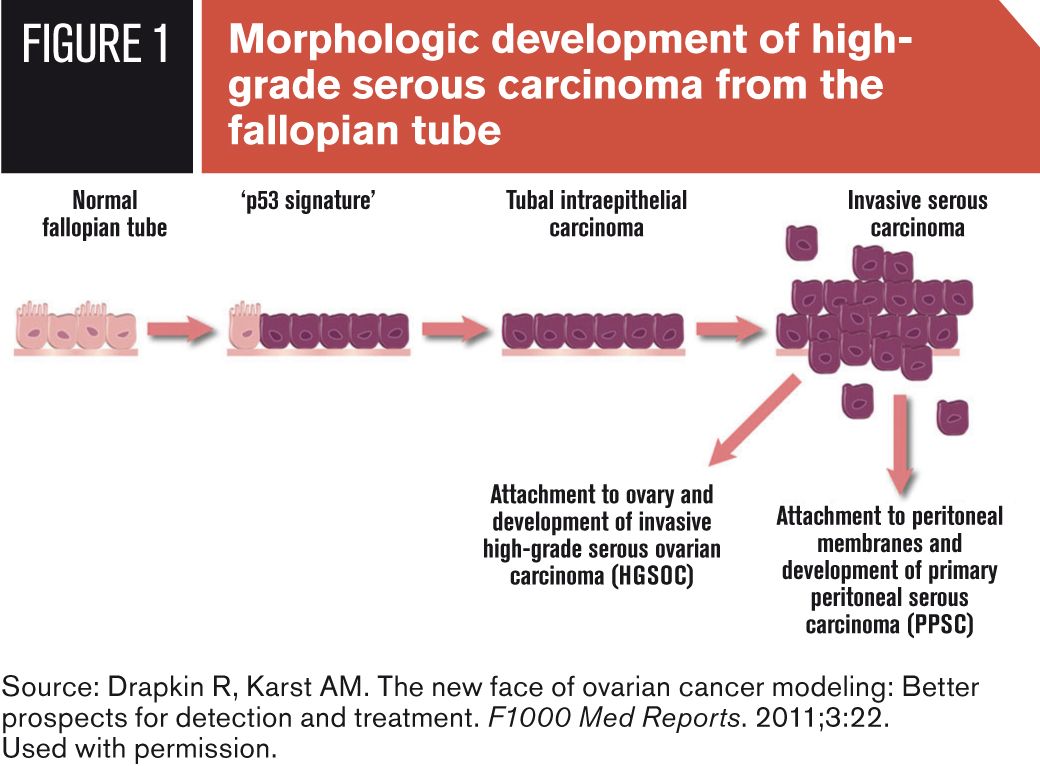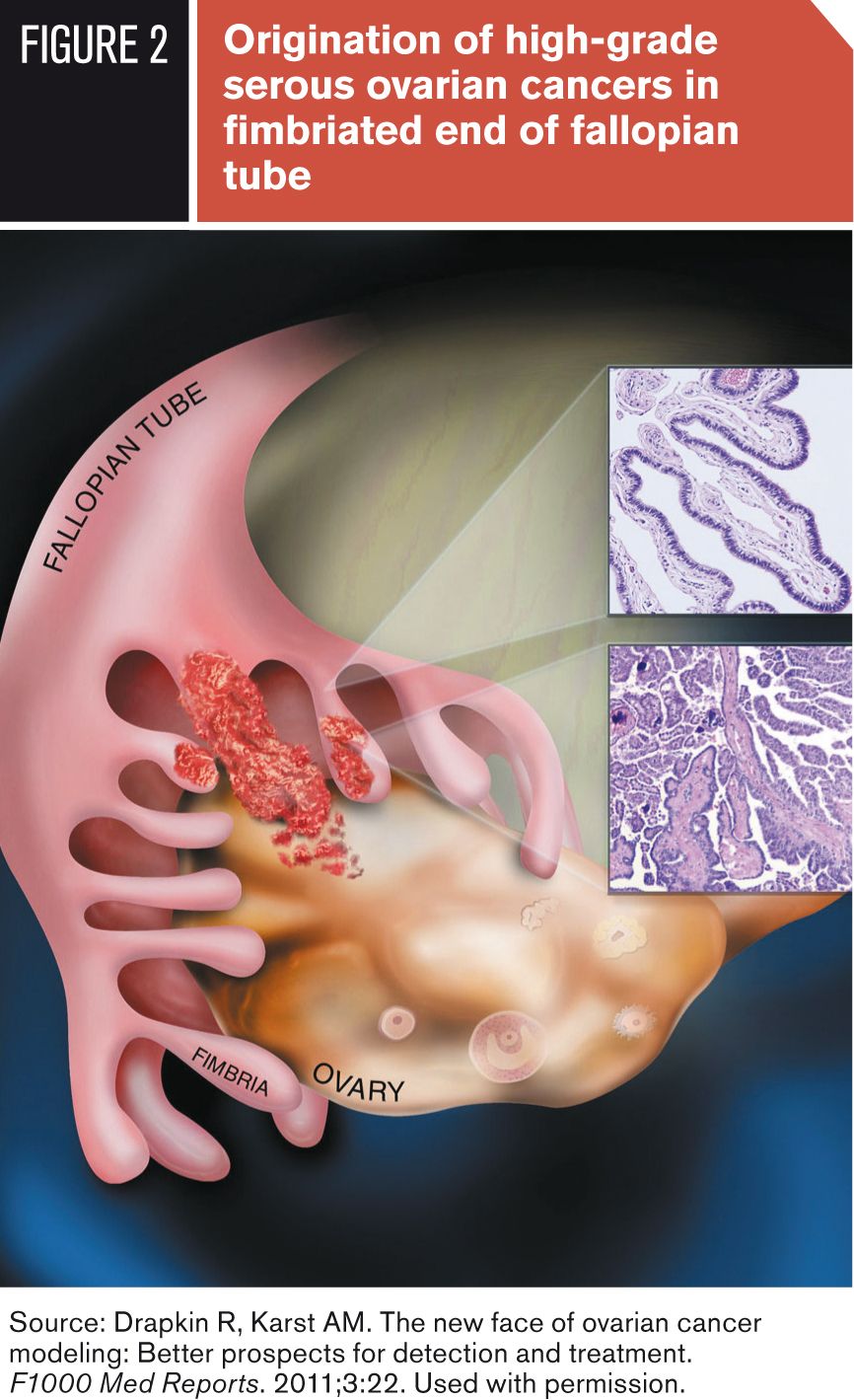Prophylactic salpingectomy: The future of ovarian cancer prevention?
Ovarian cancer is notorious for its late stage at diagnosis and its poor prognosis. In the absence of good screening tests, salpingectomy is the only form of prophylaxis for this cancer.

Dr. Tellawi is Resident, Department of Obstetrics, Gynecology and Reproductive Sciences, University of Maryland School of Medicine, Baltimore, Maryland.
She has no conflicts of interest to disclose with respect to the contents of this article.

Dr. Morozov is Assistant Professor, Department of Obstetrics, Gynecology and Reproductive Sciences, University of Maryland School of Medicine, Baltimore, Maryland.
He reports receiving royalties from Solour Surgical, holding patents for surgical devices for pelvic organ prolapse and total laparoscopic hysterectomy, receiving a grant from TEDCO/MII, holding ownership interest in Titan Medical, and serving as a consultant/proctor for Intuitive Surgical.
Ovarian cancer is notorious for its late stage at diagnosis and its poor prognosis. Many theories have circulated about the origin and development of ovarian cancer in both BRCA-positive and BRCA-negative women. Earlier theories emphasized that ovarian cancer originates in the ovary, with multiple cycles of ovulation, as well as possibly pelvic inflammation, triggering mutations that ultimately lead to loss of tumor suppressor control.
Newer research, however, shows that ovarian cancer may originate in the fallopian tube, and more specifically, the fimbriated end of the fallopian tube. This leads practitioners to ask the questions: Should I offer my patients prophylactic salpingectomies for primary ovarian cancer prevention? Should both tubes be removed in their entirety during elective surgeries, such as tubal ligations and hysterectomies?
Although there are no prospective randomized clinical trials that address this issue, we will examine the concept here.
The scope of the problem
Nearly 22,000 women are diagnosed with ovarian cancer each year in the United States alone and 190,000 globally; it contributes to nearly 16,000 deaths in the United States and 114,000 deaths worldwide each year.1 Although there are modifiable risk factors for ovarian cancer, such as use of oral contraceptives, family history is one factor that cannot be modified. At least 10% of ovarian cancers originate in BRCA-positive women, who have a 27%–56% lifetime risk of developing ovarian cancer. BRCA-positive women who choose to have prophylactic surgery have an approximately 96% rate of cancer-free survival, whereas those who opt for close surveillance have a 69% cancer-free rate.2
The success rate for prophylactic surgery in the BRCA population is based on one principle: removing tissue that has the potential to become malignant before it can do so. Where ovarian cancer originates is a question that must, therefore, first be answered so that prophylactic surgeries can be done to remove as little tissue as possible while maximizing the benefit for the patient.
Theories on ovarian cancer development
There are 2 widely circulated theories on the origins and progression of ovarian cancer. Endometroid and clear-cell carcinomas are thought to originate from multiple genetic events, such as mismatch repair mutations, that activate the KRAS/BRAF pathway, beta-catenein activation, and PTEN mutations, which then progress to cancer. Mutations in the KRAS/BRAF pathway tend to lead to a slower progression in ovarian cancer development.
Some researchers theorize that retrograde flow from the uterus creates endometriotic cysts on the ovaries that predispose to the changes in the cell cycle pathways.3 Others theorize that ovarian cancer originates from endometriosis, via damage from exposure to Mullerian factors during menstruation, or even from inclusion cysts on the ovary that invaginate and, in that process, accrue DNA damage. Still other researchers theorize that pelvic inflammation may cause similar oxidative stress and pathway alterations.4
The histology of other epithelial ovarian cancers may follow a more malignant pathway involving p53 tumor suppressor mutations. Such mutations lead to the development of serous carcinoma, which metastasizes rapidly by direct peritoneal spread.
The theories beyond what triggers these changes to tumor suppressor genes are many. In 1971, Fathalla developed the “incessant ovulation theory,” which held that constant damage, via oxidative stress, and repair of the ovarian epithelium after each cycle of ovulation led to an increased chance of tumor development.5
Cramer and Welch in 1983 hypothesized that regular gonadotropin stimulation and elevated estrogen levels stimulate proliferation of the ovarian epithelium; with stimulation comes the risk of DNA damage and progression to cancer.6
NEXT: ADVANCES IN UNDERSTANDING OVARIAN CANCER >>
Advances in understanding ovarian cancer
In recent years, researchers at the Massachusetts General Hospital (Boston) and other institutions have found strong p53-positive sites at the fimbriated ends of the fallopian tubes of both BRCA-positive and BRCA-negative women.1 In their 2007 paper, Crum et al used a protocol for sectioning and extensively examining the fimbriated end (SEE-FIM) to search for p53-signatures, sites where there were multiple copies of the p53 tumor suppressor genes.2 They also looked for signs of early tubal intraepithelial carcinomas (TICs) and p53 signatures in women with a history of BRCA mutation who had undergone prophylactic surgery, and women who had surgery for other benign or malignant conditions (eg, fibroids or endometrial cancer).
They found that 80% of women with BRCA mutations and 89% of women without that genetic history had p53 signatures in the fimbriated end of the fallopian tube, and 100% of the TICs they found were associated with the p53 signature.
Inflammation from consistent ovulation, as well as retrograde flow during menstruation, could be the trigger that sets off the cascade of p53 expression, mutation, and metaplasia (Figure 1).4,7 Although ovarian cancer may originate from these p53 signature sites in the fimbria, ovarian cancers are not referred to as primary tubal cancers because the tubal component is not the dominant component, nor is it the first to be identified in most cases of ovarian cancer (Figure 2).7,8
This new theory of ovarian carcinogenesis presents new questions for gynecologic surgeons. Can a simple salpingectomy be offered to BRCA-positive patients in the future? Would a prophylactic salpingectomy at the time of hysterectomy or tubal ligation be the best way to help BRCA-negative women avoid the potential risk of developing ovarian cancer? Should all such women be offered a bilateral salpingo-oophorectomy (BSO)?


NEXT: THE BRCA-NEGATIVE AND BRCA-POSITIVE POPULATIONS >>
The BRCA-positive population
Studies performed in the late 1990s showed that early serous carcinomas of the fallopian tube were present in 2%–10% of BRCA-positive patients undergoing prophylactic BSO.2 Kindelberger et al studied 55 tubes and ovaries from BRCA-positive women and noted that 41 (75%) had tubal (n = 5), peritoneal
(n = 6), or ovarian (n = 30) carcinomas and that foci of TIC were identified in 5 of 5, 4 of 6, and 20 of 30 of these cases, respectively.9 Ninety-three percent of TICs involved the fimbriae.
Many BRCA-positive women are offered prophylactic bilateral mastectomies and BSOs after their diagnosis is confirmed. These women often wait until after their childbearing years to perform the BSO, in hopes that they will have children and also maximize their time before entering surgical menopause. Yet a significant proportion of these women already have TICs present in their tubes at the time of their prophylactic surgeries, and others have already have progression to ovarian cancer.
At the 24th Annual Ella T. Grasso Ovarian Cancer Symposium, the suggestion of bilateral salpingectomy with ovarian retention (BSOR), and eventual oophorectomy for risk reduction at or near the average age of menopause, were discussed.10,11
Leblanc et al coined the term “radical fimbriectomy” for BSOR and performed this procedure on a group of 14 BRCA-positive patients.3 Both tubes and the fimbrio-ovarian junction were laparoscopically removed, as well as one-quarter of the ovary itself, while preserving the ovary’s blood supply in the infundibulopelvic ligament. The team then waited 15 minutes to confirm that blood supply to the ovary remained patent despite the partial oophorectomy.
In their pathology results, they found that 2 of 14 women had p53 signatures in the fimbriated end of the fallopian tube, and 1 of those 2 also had a similar mutation in the small portion of the ovary that was adjacent to that fimbriated end.3 The patients who had this procedure done would require close monitoring in the future, given their BRCA history.
Although this study was small, the work of this team is novel, and presents a good basis upon which to build future studies.
The BRCA-negative population
A change in approach for ovarian cancer prophylaxis for the BRCA-negative population is one that should be both feasible and easy to implement but requires rigorous testing. In this population, tubal involvement is found in at least 15% of ovarian cancers during pathology assessment.2
Studies have shown that patients who have received a simple bilateral tubal ligation (BTL) or hysterectomy, using the current widely used techniques, have had decreased rates of development of ovarian cancer.12-14
Some may question whether a total hysterectomy and BSO must be performed to ensure that all segments of the fallopian tube have been removed. In 2010, Cass et al found that a full BSO does not leave behind residual tube, nor does the cornual portion of the tube develop cancer, but some practitioners and patients may continue to worry despite these data.15
By using the procedure outlined by Leblanc’s team, it should be easy and possible to offer women requesting a bilateral tubal ligation a BSOR, and to incorporate a salpingectomy at the time of hysterectomy for benign disease.
Future directions
The question of the best mode for ovarian cancer screening and prevention is a fundamental one that researchers across the world have been working to answer. Research has clearly shown that the fimbriated end of the fallopian tube contains p53 signatures, or precursor lesions that lead to the development of ovarian cancers in both BRCA-positive and BRCA-negative populations.
This leads to a window of opportunity for gynecologists: offering patients a salpingectomy during benign gynecologic surgeries as one of the few options available for ovarian cancer prophylaxis for the general population. It likewise provides BRCA-positive patients with the possibility of having bilateral salpingectomies with ovarian retention until they approach menopause.
Questions remain
Research has not yet determined an exact percentage of BRCA carriers in whom TICs lead to cancer. We do not know the pathways by which tubal ligations reduce the risk of cancer. It is not known at what age it would be best to perform salpingectomy, nor how long may be best to wait before performing subsequent oophorectomy in order to maximize risk reduction.
On a related note: Would ovarian retention, along with the retention of the estrogen and progesterone the ovary produces, also increase the risk of earlier breast cancers in these women, if they have not yet had prophylactic mastectomies?
In our opinion, introduction of bilateral salpingectomies at the time of tubal ligation or hysterectomy for benign gynecologic patients is a reasonable option. In the absence of good screening tests, this procedure is the only form of prophylaxis for a cancer that is difficult to detect and often lethal when found.
Physicians should at least present patients with this option during presterilization and prehysterectomy counseling. Prospective studies will need to be conducted to see if this procedure actually does decrease the risk of ovarian cancer development over time.
References
1. Lee, Y, Miron A, Drapkin R, et al. A candidate precursor to serous carcinoma that originates in the distal fallopian tube. J Pathol. 2007;211:26–35.
2. Crum CP, Drapkin R, Kindelberger D, Medeiros F, Miron A, Lee Y. Lessons from BRCA: The tubal fimbria emerges as an origin for pelvic serous cancer. Clin Med Res. 2007;5:35–44.
3. Leblanc E, Narducci F, Farre I, et al. Radical Fimbriectomy: A reasonable temporary risk-reducing surgery for selected women with a germ line mutation of BRCA 1 or 2 genes? Rationale and preliminary development. Gynecol Oncol. 2011:121:472–476.
4. Salvador S, Gilks B, Kobel M, Huntsman D, Rosen B, Miller D. The Fallopian Tube: Primary site of most pelvic high-grade serous carcinomas. Int J Gynecol Cancer. 2009;19:58–64.
5. Fathalla MF. Incessant ovulation-a factor in ovarian neoplasia? Lancet. 1971;2:163.
6. Cramer DW, Welch WR. Determinants of ovarian cancer risk. II. Inferences regarding pathogenesis. J Natl Cancer Inst. 1983;71(4):717–721.
7. Drapkin R, Karst AM. The new face of ovarian cancer modeling: Better prospects for detection and treatment. F1000 Med Reports. 2011;3:22.
8. Crum CP, Drapkin R, Miron A, et al. The distal fallopian tube: A new model of pelvic serous carcinogenesis. Curr Opin Obstet Gynecol. 2007;19:3–9.
9. Kindelberger DW, Lee Y, Miron A, et al. Intraepithelial carcinoma of the fimbria and pelvic serious carcinoma: Evidence for a causal relationship. Am J Surg Pathol. 2007;31:161–169.
10. Dietl J, Wischhusen J, Hausler SFM. The post-reproductive Fallopian tube: better removed? Hum Reprod. 2011;46(11):2918–2924.
11. Greene MH, Mai PL, Schwartz PE. Does bilateral salpingectomy with ovarian retention warrant consideration as a temporary bridge to risk-reducing bilateral oophorectomy in BRCA1/2 mutation carriers? Am J Obstet Gynecol. 2011;204:19.e1-6.
12. Green A, Purdie D, Bain C, et al. Tubal sterilization, hysterectomy and decreased risk of ovarian cancer. Survey of women’s Health Study group. Int J Cancer. 1997;71(6):948–951.
13. Hankinson SE, Hunter DJ, Colditz GA, et al. Tubal ligation, hysterectomy, and risk of ovarian cancer. A prospective study. JAMA. 1993;270(23):2813–2818.
14. Berek JS, Chalas E, Edelson M, et al. Prophylactic and risk-reducing bilateral salpingo-oophorectomy. Obstet Gynecol. 2010;116(3):733–743.
15. Cass I, Walts A, Karlan BY. Does risk-reducing bilateral salpingo-oophorectomy leave behind residual tube? Gynecol Oncol. 2010;117:27–31.
HP-hMG stimulation reduces OHSS risk in high responder patients
October 25th 2024A recent study found that highly purified human menotropin significantly lowers the risk of ovarian hyperstimulation syndrome compared to recombinant follicle stimulating hormone, highlighting the benefits of protocol individualization based on gonadotropin type.
Read More
Racial disparities in high-risk endometrial subtype diagnoses reported
October 24th 2024In a recent study, Black patients were significantly more likely to present with high-risk endometrial subtypes for endometrial cancer, highlighting disparities in access to tumor next generation sequencing.
Read More
Shift towards neoadjuvant chemotherapy found in ovarian cancer treatment
October 21st 2024A recent study shows a significant decrease in primary cytoreductive surgery utilization for advanced ovarian cancer, as neoadjuvant chemotherapy followed by interval cytoreductive surgery gains acceptance for its noninferior survival outcomes and reduced postoperative morbidity.
Read More
